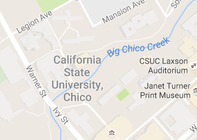Areas of Immediate Focus |
Transportation |
Chico’s 2020 Climate Action Plan identifies transportation as the largest source of GHG emissions, emitting over twice as much as the entire Energy sector. Business as Usual (BAU) projections show transportation emissions increasing significantly by 2020 if not mitigated. To reach Target 2020 Emissions, transportation emissions need to be reduced to 32% below BAU levels.
Reduce Vehicle miles traveled
Reducing vehicle miles traveled (VMT) is essential to reducing Chico’s transportation GHG emissions. Increasing B-Line bus ridership is one method of reducing VMT. Encouraging citizens to carpool, bike, and walk instead of driving will also reduce VMT and associated emissions. Chico must continue planning, maintaining, and promoting safe routes for walking and biking. increase use of electric vehicles
Electric vehicles (EVs) are increasing in popularity as prices decrease and have the potential to replace a fraction of Chico’s internal combustion vehicles. While EVs do not consume gasoline or emit pollutants, they do require electricity. Planning for an increase in EVs can be accomplished by installing charging stations in parking areas, as well as increasing the amount of grid energy coming from renewable sources. |
Home Energy Use |
PG&E’s Energy Summary for Chico 2005 to 2015 shows a 7.4% increase in residential energy (electricity and natural gas) use from 2005 to 2015. Residential energy usage in Chico accounts for 51% of Chico’s energy usage. Electricity accounts for 42% of residential usage, with natural gas accounting for the other 58%. While natural gas has leveled off to approximately 2005 use, electricity consumption has increased by 13.8% since 2005, reaching a peak of 21.4% above 2005 levels in 2012. Because of this increase, energy efficiency outreach and policy is especially important.
improve energy efficiency
One such effort is the Draft Residential Remodel Ordinance. The Sustainability Task Force (STF) identified improving energy efficiency of existing homes as a priority to meet the City’s greenhouse gas emissions reduction goal. It is estimated that approximately 60-70% of homes in Chico were built before 1991, before the Title 24 Building Energy Codes were fully effective. Over the course of several meetings in 2016, the STF worked closely with the City’s Building Official to draft residential remodel building code language that would require a homeowner to install basic energy efficiency measures (e.g., ceiling insulation, weather stripping, programmable thermostat, etc.) for the entire home if the remodel exceeds 50% of the existing floor area of the structure. The proposed code language closely mirrors the City’s highly successful Residential Energy Conservation Ordinance, which requires similar energy efficiency upgrades at the time of sale for single-family and multifamily homes. The benefits of the draft remodel requirements include reduced energy and water use and thereby utility cost savings. The ordinance is due to be acted upon by Council in 2017. |
Organic Waste Recycling |
The EPA identifies landfills as the largest source of methane emissions in the US. These methane emissions caused by organic waste decomposing anaerobically in landfills contributes to greenhouse gas emissions. Chico’s landfill waste is sent to a facility that produces energy from methane capture. However, methane capture only occurs once the waste is sealed in the landfill, and decay still occurs before methane capture begins. The EPA also estimates that 25% of methane escapes from landfills. Therefore, it is important to divert organic waste from landfills.
enforce existing legislation
In October of 2014, Governor Brown signed AB 1826, requiring businesses to recycle their organic waste on and after April 1, 2016, depending on the amount of waste they generate per week. As of January 1, 2017, businesses that generate four cubic yards of organic waste per week shall arrange for organic waste recycling services. The purpose of this legislation is to reduce GHG emissions, especially methane, by diverting commercial organic waste from landfills. There is a lack of defined enforcement measures for AB 1826, or a clear plan for how Chico businesses should recycle their organic waste. The City of Chico has been attempting to negotiate waste franchises agreements with Waste Management and Recology that would assign service zones divided on a split of the current customer base. The agreement would require haulers to offer a suite of recycling services, including organics recycling, as well as set the maximum rates for both commercial and residential services. A waste hauler franchise agreement that assigns service zones would also reduce unnecessary routes for haulers. |
